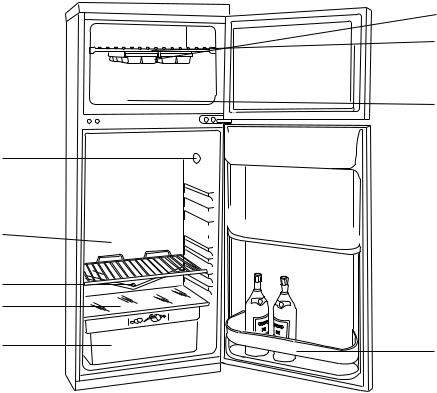Zanussi Z22-5W User Manual

REFRIGERATOR-
FREEZER
Z 22/5 W
Z 22/5 SI
INSTRUCTION BOOKLET
2222 139-81
IMPORTANT SAFETY INFORMATION
It is most important that this instruction book should be retained with the appliance for future reference. Should the appliance be sold or transferred to another owner, or should you move house and leave the appliance, always ensure that the book is left with the appliance in order that the new owner can get to know the functioning of the appliance and the relevant safety information.
This information has been provided in the interest of safety. You MUST read it carefully before installing or using the appliance.
Installation
¥This appliance is heavy. Care should be taken when moving it.
¥It is dangerous to alter the specifications or attempt to modify this product in any way.
¥Care must be taken to ensure that the appliance does not stand on the electrical supply cable. Important: if the supply cable is damaged, it must be replaced by a supply cable available from your local Service Force Centre.
¥Any electrical work required to install this appliance should be carried out by a qualified electrician or competent person.
¥Parts which heat up should not be exposed. Whenever possible, the back of the appliance should be close to a wall but leaving the required distance for ventilation as stated in the installation instructions.
¥The appliance should be left for 2 hours after installation before it is turned on, in order to allow the refrigerant to settle.
Child Safety
¥Do not allow children to tamper with the controls or play with the product.
¥Keep all packaging well away from children.
During Use
¥This appliance is designed for domestic use only, specifically for the storage of edible foodstuffs.
¥Frozen food must NOT be re-frozen once it has thawed out.
¥Do not place carbonated or fizzy drinks in the freezer.
¥Do not remove items from the freezer if your hands are damp/wet, as this could cause skin abrasions or frost/freezer burns.
¥Ice lollies can cause Ôfrost/freezer burnsÕ if consumed straight from the freezer.
¥ManufacturersÕ storage recommendations should be strictly adhered to. Refer to relevant instructions.
¥The cooling plate or refrigerated freezer shelves in this appliance contain channels through which the refrigerant passes. If these are punctured this will cause substantial damage to the appliance and result in food loss. DO NOT USE SHARP INSTRUMENTS to scrape off frost or ice. Under NO circumstances should solid ice be forced off the lining or shelves. Solid ice should be allowed to thaw, when defrosting the appliance. See Defrost Instructions.
Maintenance and Cleaning
¥Switch off and unplug the appliance before carrying out any cleaning or maintenance work.
Servicing
¥This product should be serviced by an authorised engineer and only genuine spare parts should be used.
¥Under no circumstances should you attempt to repair the machine yourself. Repairs carried out by inexperienced persons may cause injury or serious malfunctioning. Refer to your local Zanussi Service Force Centre and always insist on genuine spare parts.
At the end of the Appliance Life
¥When disposing of your appliance, use an authorised disposal site.
¥Remove the plug and ensure that any locks or catches are removed, to prevent young children being trapped inside.
2
CONTENTS
Instructions for the User
Important Safety Information |
2 |
Description of the Appliance |
4 |
Operation |
5 |
Before use |
5 |
Setting the temperature |
5 |
Freezing fresh food |
5 |
Storage of frozen food |
5 |
Thawing |
6 |
Making ice cubes |
6 |
Fresh food refrigeration |
6 |
Movable shelves |
7 |
Freezing calendar |
7 |
Hints and Tips |
8 |
Maintenance and Cleaning |
9 |
Internal cleaning |
9 |
External cleaning |
9 |
When the appliance is not in use |
9 |
Changing the light bulb |
9 |
Defrosting |
9 |
Something Not Working |
11 |
Service and Spare Parts |
12 |
Customer Care |
12 |
Guarantee Conditions |
13 |
Instructions for the
Installer
Technical Specification |
14 |
Installation |
15 |
Positioning |
15 |
Rear Spacers |
15 |
Electrical Connection |
16 |
Door Reversal |
17 |
2222 139-81 |
3 |
|

DESCRIPTION OF THE APPLIANCE
A
B
 C M
C M 
 D
D
L
 E
E
I |
|
H |
|
G |
F |
|
A - Ice trays
B -Shelf for freezing fresh food
C -Frozen food storage
D -Dairy compartment
E - Can storage shelf
F - Bottle storage shelf
G -Salad drawer
H -Glass shelf
I - Drain channel
L - Storage shelves
M- Thermostat control for both compartments
4

OPERATION
Before using
Remove all securing tapes. Wash inside the appliance with lukewarm water and bicarbonate of soda (5 ml to 0.5 litre of water).
Do not use soap or detergent as the smell may linger. Dry thoroughly.
Setting the temperature
The temperature inside the refrigerator is regulated by a thermostat with 6 temperature positions and one ÇOFFÈ (O) position.
Position 1 = minimum coldness Position 6 = maximum coldness
Turn the thermostat dial to the required position.
The intermediate position is usually the most suitable (3-4).
The thermostat setting can vary as the temperature inside the refrigeration compartment depends on the following factors:
Ðroom temperature
Ðhow often the door is opened
Ðhow much food is stored
Ðposition of the appliance
 Important
Important
During prolonged periods of abnormally hot weather, if the thermostat is set on too high a number, the cooling system may operate continuously and the fridge cooling plate may not defrost. Turning the knob to a lower number will cause the automatic defrosting to resume.
The freezer compartment
The four-star freezer compartment is suitable for storage of commercially frozen food and for freezing fresh foods.
Freezing fresh food
To freeze fresh foods it is not necessary to change the setting of the thermostat knob.
However, for a quicker freezing operation, turn the thermostat knob to the coldest setting; but remember that, in this condition the refrigerator compartment temperature might drop below 0¡ C.
If this occurs reset thermostat knob to a warmer setting.
In any 24 hours you can freeze up to 3 kg. of fresh food.
Place the food to be frozen on the shelf of the freezer as this is the coldest part.
 Important
Important
In the event of a power cut do not open the door. The food in the freezer will not be affected if the power cut is short and if the freezer is full. Should the food begin to thaw, it must be consumed quickly and must not be re-frozen. (See ÒHints & TipsÓ).
Storage of frozen food
When first starting-up or after a period of non use, before putting the products in the compartment let the appliance run for at least two hours on the coldest setting, then turn the thermostat knob to the normal opertion position.
Do not exceed the storage period indicated by the manufacturer.
Finally, do not open the door frequently or leave it open longer than is absolutely necessary.
 Warning
Warning
Do not put carbonated liquids, (fizzy drinks etc.), in the freezer compartment.
Ice Iollies, if consumed immediately after removal from the freezer, can cause low temperature skin burns.
Do not remove items from the freezer if your hands are damp/wet, as this could cause skin abrasions or Òfrost/freezer burnsÓ.
5
Thawing
Frozen food, prior to being used, can be thawed in the fridge or at room temperature depending on the time available. Small food items may even be cooked from frozen; in this case cooking will take longer.
Any frozen food which is allowed to thaw accidentally should either be eaten as soon as possible or thrown away. Alternatively, if the food is uncooked and has not been completely defrosted it can be cooked and then refrozen.
Meat, fish and fruit should be thawed in the refrigerator compartment and small pieces of meat can even be cooked while still frozen, but you must ensure that it is thoroughly cooked through.
Vegetables should be directly immersed in boiling water; ready-cooked dishes can be placed directly in the oven in their aluminium wrapping.
A microwave oven is particularly suitable for thawing any type of frozen food: follow the oven instructions, particularly regarding the placement of aluminium wrapping or containers in the oven.
Defrosted cooked food must never be refrozen.
Making ice cubes
The appliance is provided with one or more trays for ice-cubes trays.
Fill the tray(s) 3/4 full to give the ice space to expand and place them in the freezer compartment.
To release the ice cubes simply give the tray a slight twist.
Do not use sharp or metallic instruments to remove the trays from the freezer.
Fresh food refrigeration
To obtain the best performance, do not store warm food or evaporating liquids in the refrigerator; do cover or wrap the food, particularly if it has a strong flavour.
Do not cover the shelves with any protective material, such as paper, cardboard or plastic, which may obstruct the air circulation through them.
To help you use your refrigerator correctly, here are some more useful hints:
Raw meat (beef, pork, lamb & poultry or chicken): wrap in polythene bags and place on top of the salad crispers.
Meat can only be stored safely in this way for one or two days at the most.
Fruit & vegetables: these should be thoroughly cleaned and placed in the bottom salad drawer.
Butter & cheese: these should be placed in special airtight containers or wrapped in aluminium foil or polythene bags to exclude as much air as possible.
Milk bottles: these should have a cap and should be stored in the bottle rack on the door.
6
